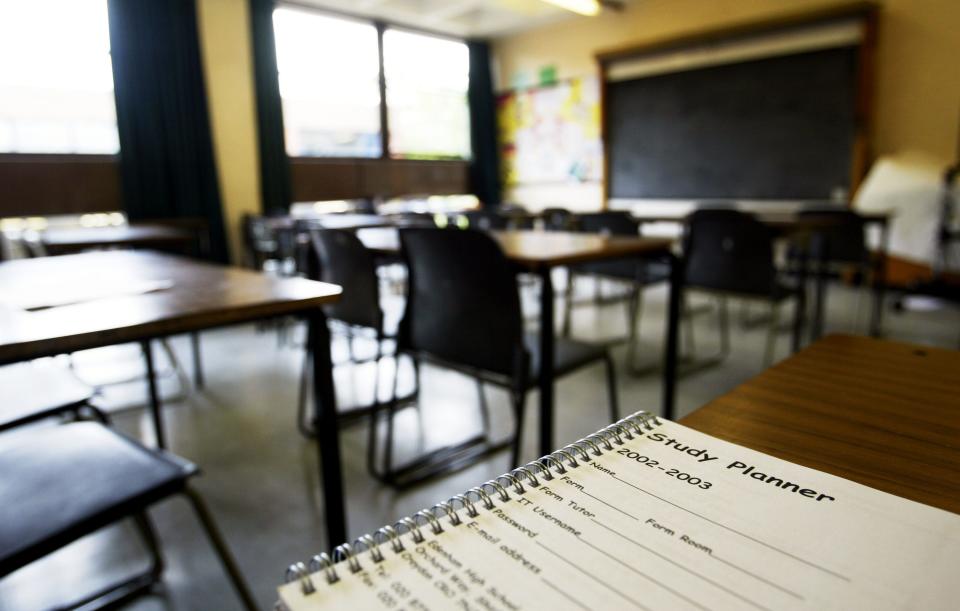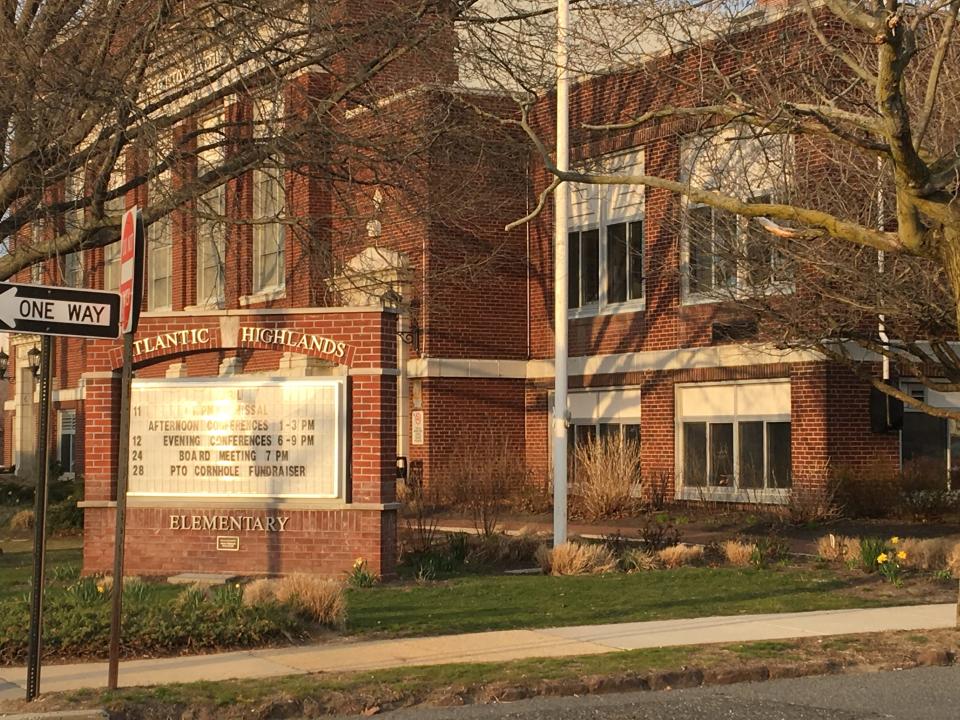New Jersey public schools are losing students. Why? And where are they going?
Fewer and fewer children are attending public schools in New Jersey.
Across the Garden State, public school enrollment dropped by nearly 36,000 students between 2012-13 and 2022-23, according to analysis by the Asbury Park Press. The drops are causing budget strains in many places as state funding, tied to enrollment, is slashed, education officials said.
The Press analyzed 10 years of Department of Education enrollment data. The data show that in Monmouth County, enrollment dropped by 9.7% between the 2012-2013 school year and 2022-2023. In Ocean County, it dropped by 10.8%. All told, public schools enrolled 18,000 fewer students in Monmouth and Ocean Counties.
It's led some districts to get creative in efforts to reverse the trend.
"We invited many of the local realtors from in town and neighboring towns, and we took them on a tour of the high school and we showcased a lot of our programs," said Barnegat Superintendent Brian Latwis, where enrollment is up 13%. "They got to see firsthand a lot of the new things that we've brought here to enhance our student experience."
Barnegat is an exception, both locally and around the state. In New Jersey's northwest, Sussex, Warren and Hunterdon counties also lost significant proportions of their student populations over the time period analyzed.
Even though the state's population has remained relatively stable, why are fewer children going to school, particular in New Jersey's suburbs?
New Jersey's declining birth rate
Part of the explanation comes from a slowdown in the birthrate across the nation.
Like the country, New Jersey's birth rates have fallen since a peak in 2007, said James Hughes, dean emeritus of Rutgers University's Edward J. Bloustein School of Planning and Public Policy and an expert in demographics.
"In 2007, the fertility rate was sort of a mini peak at 2.1 (births per woman), and that's the replacement level fertility," said Hughes. The number indicates "for that moment in time, or that year, how many children a woman would have during her lifetime."
Maintaining replacement level fertility would keep the population steady across New Jersey; however in the years since, birth rates have dipped and continue to decline.
Across the state, the annual number of births per 1,000 people is down from 13.4 in 2007 to 10.9 in 2021, according to the state Department of Health.
In school districts across New Jersey, the results are stark in some cases, according to state Department of Education data. Enrollment at Belmar Elementary dipped 30%, from 568 to 394 students, between the 2012-13 and 2022-23 school years. Brick Township public schools lost 15% of their student population, down from 9,586 in 2012 to 8,158 by 2022. Neptune Township schools reported 22% fewer students, down 4,413 to 3,435 over the same time period.
Millennials, the cohort currently between 27 and 42 years old, are not having as many children as previous generations, Hughes said.
After the 2008 financial crisis, "people (who were) in their 20s there, which was the leading edge of millennials, they had real career setbacks. So they had a lot of ground to make up," he said. "I think there's just a general trend in advanced industrial nations (to have fewer children), given work patterns, two (income) working households, and… given the expense of educating a child."

William George, director of educational leadership at Monmouth University, remembers studying the declining enrollment problem at Middletown Township School District when he served as superintendent. George said the district's population was once about 12,000 students.
Over the past 10 years though, the student population has declined by 951 students, or nearly 10%, to 8,883 in 2022, according to New Jersey Department of Education enrollment records.
"It was declining birth rates in the communities here that we (Middletown school administrators) attributed to that (drop)," George said.
The enrollment downward slide in public schools continues even as the COVID-19 pandemic recedes into the past: Across Monmouth and Ocean counties, public school enrollment slumped 4% — down nearly 7,000 students — between 2019 and 2023.
While some of those drops are due to smaller family sizes, private schools and online academies are also attracting some students away from traditional public school education, George said.
"Now, post-COVID, there's many more factors (driving declining enrollment)… There are more options than there were before," George said.
Private schools and homeschooling grow
In the years since the COVID-19 pandemic showed parents how technology could open doors to learning in new ways, private schools, homeschooling and online academies have become increasingly popular.
In the fall of 2019, months before the COVID-19 pandemic closed schools and disrupted education across the nation, 9% of elementary and high school students in the United States were enrolled in private schools, according to the National Center for Education Statistics. By 2021, private school enrollment was gaining ground and had risen to 13%, according to the American Community Survey.
While Ocean County has lost public school students, private school enrollment is surging across the northern portion of the county. As of September, 42,307 Lakewood students attended non-public schools. As of May, roughly one-in-three school-aged children in Jackson — more than 3,800 students — attended non-public schools.
As Lakewood's private school enrollment grew, its public school population declined 12% to 4,531 between 2012 and 2022, according to the state education department.
Michael Inzelbuch, attorney for Lakewood Public School District, said some of that decline is the result of roughly 430 students attending the local Ocean Academy Charter School.
The population decline in Lakewood has coincided with a financial crisis so severe that school leaders have repeatedly sought millions of dollars in state loans in order to maintain services and busing for all students.
Related: Lakewood schools borrowed millions from New Jersey and still can't pay its bills
"We have not cut any programs," Inzelbuch said in an email to a reporter. "We have consolidated some classes and we have reconfigured the schools – for example – 6th grade is no longer at the middle school, but is dispersed amongst grade schools."
In addition, several vacant positions have not been filled, he said.
Despite the drop over the past decade, "we see… a significant increase at the High School level – more than 1300 students for the past two years," Inzelbuch said. "Our preschool is increasing and reaching maximum levels due to the ever-increasing special needs population that is opting for public preschool."
Another drain on New Jersey's public school classrooms is the increasing popularity of homeschooling.
In 2019, just 1,295 New Jersey students transferred out of public schools into homeschool programs, according to the state Department of Education. However, by 2020, with the pandemic forcing schools to switch to remote instruction, the number of students who transferred to homeschool programs ballooned to 5,326, according to the state department.
In the following two school years, another 7,267 New Jersey students left public schools to be educated at home, according to the department.
Why does it matter?
Lower enrollment can be a serious problem for New Jersey's school districts, because those that face shrinking student populations also see their state aid slashed, regardless of the inflation rate.
In schools with tight budgets, these converging impacts can create financial havoc. In Jackson schools — where the student population dropped 18%, or 1,660 students, between 2012 and 2022 — school officials say they lost $18 million in state aid over the past six years. Classroom sizes have swelled to about 30 students, leaving the district to ask voters to approve a special ballot measure that would raise school taxes by $4 million for new teachers and staff.
Freehold Regional High School District — where enrollment dropped 11% over the last decade — was forced to consider eliminating courtesy busing to balance its budget after state aid dropped from $30.5 million to $23.7 million, or 22.14%, earlier this year. A deal in Trenton signed in August brought relief and restored busing to more than 3,000 affected students.
The problem is forcing educational leaders to get creative to attract students.
"Do I think we're going to have to do things differently? Absolutely," said George, of Monmouth University. "I see places where that's happening. Look at Henry Hudson, Highlands and Atlantic Highlands."

All three districts had shrinking student populations over the past decade. Voters approved a merger last month that will reduce costs and eliminate triplication of administrative jobs.
Barnegat Township School District held a special seminar with realtors last year, a move school leaders hoped would attract families with children to purchase homes within the area.
The district's large preschool program has helped to attract young families to the area, as well as its successful marching band, recording arts program, athletics and extracurriculars, he said.
Latwis, the superintendent, said new home construction has also kept Barnegat schools growing — up 13% in the past decade, according to state records — while many neighboring districts shrink.

School quality is a "huge driving force… for families when they decide where they're going to move," the superintendent said. "When they see a lot of those really amazing things that are going on here, I think… it makes it a very easy decision to move here."
Immigration slows population decline
Not all of New Jersey's school districts are seeing the same kinds of enrollment dips that are plaguing many suburban and rural districts.
Administrators in Freehold Borough schools saw nearly 10% growth over the past decade. Interim Superintendent Rocco Tomazic said much of the growth happened even without any significant new housing being built.
Immigration has helped to keep the enrollment numbers growing. Nearly 14% of students in Freehold Borough schools were born outside the country, according to a district presentation. About 5% of students here were born in Peru, while another 3% were born in Mexico. About 23% of the district's students speak limited or no English.
The percentage of foreign-born students living in Freehold Borough has risen substantially since 2020, when 93% of students here were born in the United States, Tomazic said.
Regardless of where they were born, the children still have rights protected by the U.S. Supreme Court to education, he said.
"We're just as proud as these (foreign-born) kids as the ones who've been living here are all along," the superintendent said.
Other regions with higher proportions of immigrant residents have also reported continued growth in public schools. For example, Union County's public school enrollment grew nearly 8%, a gain of more than 7,000 new students over the past decade, according to state education department data. Overall, 31% of the county's residents are foreign-born, according to the U.S. Census.
Because of declining birth rates, "if we didn't have international migration, New Jersey would be losing population today," Hughes said.
The Garden State has "always been an immigration gateway," he said.
A century ago, New Jersey's foreign-born population was far higher than it is today, he said. About 23% of the state's residents are foreign born today; whereas in 1910, the proportion was about 30%, Hughes said.
Despite the declines in birth rates, New Jersey and the United States maintain "robust" birth rates compared to China, Japan, Italy, South Korea and most of Europe, he said.
"A lot of industrial nations have a real problem," Hughes said.
George, of Monmouth University, said the declining student population is having one positive affect: it spurs districts to provide the best possible educational opportunities to attract students. Public schools are offering new magnet programs, offering additional mental health services to meet post-pandemic needs, and bringing the latest technology into buildings, he said.
"Now more than ever, it's time to focus on that innovation," George said.
Amanda Oglesby is an Ocean County native who covers education and the environment. She has worked for the Press for more than 15 years. Reach her at @OglesbyAPP, aoglesby@gannettnj.com or 732-557-5701.
This article originally appeared on Asbury Park Press: NJ's cratering school enrollment is causing budget strains

